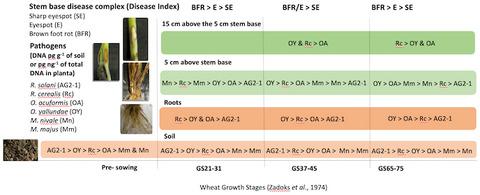当前位置:
X-MOL 学术
›
Plant Pathol.
›
论文详情
Our official English website, www.x-mol.net, welcomes your feedback! (Note: you will need to create a separate account there.)
Population dynamics of Rhizoctonia, Oculimacula, and Microdochium species in soil, roots, and stems of English wheat crops
Plant Pathology ( IF 2.7 ) Pub Date : 2020-12-03 , DOI: 10.1111/ppa.13329 Matthew Brown 1 , James W. Woodhall 2 , Linda K. Nielsen 3 , Daniel Tomlinson 1 , Arifa Farooqi 1 , Rumiana V. Ray 1
Plant Pathology ( IF 2.7 ) Pub Date : 2020-12-03 , DOI: 10.1111/ppa.13329 Matthew Brown 1 , James W. Woodhall 2 , Linda K. Nielsen 3 , Daniel Tomlinson 1 , Arifa Farooqi 1 , Rumiana V. Ray 1
Affiliation

|
This study aimed to elucidate the population dynamics of Rhizoctonia, Oculimacula, and Microdochium species, causing the stem base disease complex of sharp eyespot, eyespot, and brown foot rot in cereals. Pathogen DNA in soil, roots, and stem fractions, and disease expression were quantified in 102 English wheat fields in two seasons. Weather data for each site was collected to determine patterns that correlate with assessed diseases. Oculimacula spp. (66%) and R. solani AG 2‐1 (63%) were most frequently detected in soil, followed by R. cerealis (54%) and Microdochium spp. (33%). Oculimacula spp. (89%) and R. cerealis (56%) predominated on roots and soil but were not associated with root rot symptoms, suggesting that these species used soil and roots for survival and as inoculum source. M. nivale was more frequently detected than M. majus on stems up to GS 21–30 and co‐occurred on plant samples with O. acuformis. O. yallundae had higher DNA concentration than O. acuformis at the lower 5 cm basal region at GS 37–45. R. cerealis predominated in the upper 15 cm above the base beyond stem extension. Brown foot rot by Microdochium spp. was favoured by cool and wet autumns/winters and dominated in English wheat. Eyespot and sharp eyespot disease index by Oculimacula spp. and R. cerealis, respectively, correlated with wet/humid springs and summers. Results suggested that stem base pathogens generally coexisted; however, their abundance in time and space was influenced by favourable weather patterns and host development, with niche differentiation after stem extension.
中文翻译:

英国小麦作物的土壤,根和茎中根瘤菌,眼球菌和微线虫物种的种群动态
本研究旨在阐明的种群动态立枯病,Oculimacula和微结节品种,引起茎基病情复杂纹枯病,纹枯病,以及谷物褐腐蹄病的。在两个季节中,对102个英国麦田中的土壤,根和茎部分的病原体DNA以及疾病表达进行了定量。收集每个站点的天气数据,以确定与评估的疾病相关的模式。眼球菌属 (66%)和[R 。菌AG 2-1(63%)在土壤中最常检测到的,其次是- [R 。禾谷(54%)和微结节属。(33%)。眼球菌spp。(89%)和[R 。谷物(56%)以根和土壤为主,但与根腐病症状无关,这表明这些物种利用土壤和根来生存和作为接种源。中号。nivale比M更常被发现。最高到GS 21–30的茎上的majus,并与O一起出现在植物样品上。尖锐湿疣。Ø。yallundae比具有较高DNA浓度Ò。GS 37–45下部5 cm基底区域有尖锐湿疣。[R 。谷物在茎延伸以外的基部上方15厘米处占优势。Microdochium spp的棕脚腐烂。受凉爽和潮湿的秋季/冬季的青睐,并以英国小麦为主。眼点和尖点眼点疾病指数由Oculimacula spp提供。和- [R。谷类食品分别与春季和夏季的湿/湿相关。结果表明,茎基病原体通常共存;然而,它们在时间和空间上的丰富度受到有利的天气模式和寄主发育的影响,茎伸长后生态位分化。
更新日期:2020-12-03
中文翻译:

英国小麦作物的土壤,根和茎中根瘤菌,眼球菌和微线虫物种的种群动态
本研究旨在阐明的种群动态立枯病,Oculimacula和微结节品种,引起茎基病情复杂纹枯病,纹枯病,以及谷物褐腐蹄病的。在两个季节中,对102个英国麦田中的土壤,根和茎部分的病原体DNA以及疾病表达进行了定量。收集每个站点的天气数据,以确定与评估的疾病相关的模式。眼球菌属 (66%)和[R 。菌AG 2-1(63%)在土壤中最常检测到的,其次是- [R 。禾谷(54%)和微结节属。(33%)。眼球菌spp。(89%)和[R 。谷物(56%)以根和土壤为主,但与根腐病症状无关,这表明这些物种利用土壤和根来生存和作为接种源。中号。nivale比M更常被发现。最高到GS 21–30的茎上的majus,并与O一起出现在植物样品上。尖锐湿疣。Ø。yallundae比具有较高DNA浓度Ò。GS 37–45下部5 cm基底区域有尖锐湿疣。[R 。谷物在茎延伸以外的基部上方15厘米处占优势。Microdochium spp的棕脚腐烂。受凉爽和潮湿的秋季/冬季的青睐,并以英国小麦为主。眼点和尖点眼点疾病指数由Oculimacula spp提供。和- [R。谷类食品分别与春季和夏季的湿/湿相关。结果表明,茎基病原体通常共存;然而,它们在时间和空间上的丰富度受到有利的天气模式和寄主发育的影响,茎伸长后生态位分化。


























 京公网安备 11010802027423号
京公网安备 11010802027423号